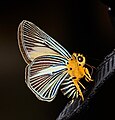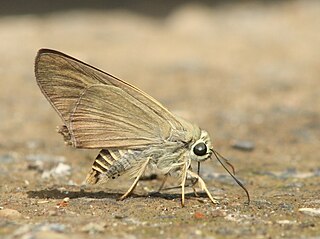
Badamia exclamationis, commonly known as the brown awl or narrow-winged awl, is a butterfly belonging to the family Hesperiidae. It is found in south and southeast Asia, Australia, and Oceania.

Burara jaina, the orange awlet, is a species of hesperid butterfly found in Asia. The butterfly was reassigned to the genus Burara by Vane-Wright and de Jong (2003), and is considered Burara jaina by them.
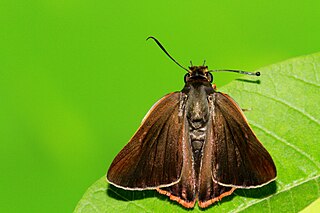
Bibasis sena, commonly known as the orange-tailed awlet, is a butterfly belonging to the family Hesperiidae, the skippers. It is also sometimes called the pale green awlet though that name can also refer to Bibasis gomata.

Choaspes benjaminii, also known as the Indian awlking or common awlking, is a species of butterfly in the family Hesperiidae. The species is named after Benjamin Delessert and was described on the basis of a specimen collected by Adolphe Delessert in the Nilgiris.

Hasora badra, the common awl, is a butterfly belonging to the family Hesperiidae, which is found in India.

Hasora chromus, the common banded awl, is a butterfly belonging to the family Hesperiidae which is found in the Indian subcontinent, Southeast Asia and Australia.

Caltoris canaraica, the Kanara swift, is a butterfly belonging to the family Hesperiidae.

Salanoemia sala, the maculate lancer, is a butterfly belonging to the family Hesperiidae found in India, Thailand, Laos and Vietnam.
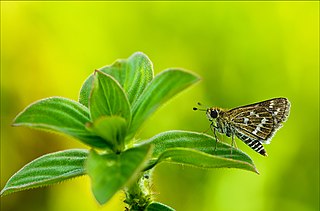
Taractrocera maevius, the common grass dart, is a species of butterfly belonging to the family Hesperiidae. It is found in India, Sri Lanka and Myanmar.
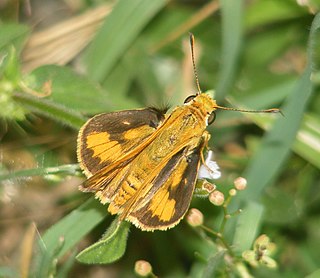
Telicota colon, commonly known as the pale palm dart or common palm dart, is a species of butterfly in the family Hesperiidae. It is found from India to Australia.

Spialia galba, the Indian grizzled skipper, is a hesperiid butterfly which is found in South Asia and parts of Southeast Asia.
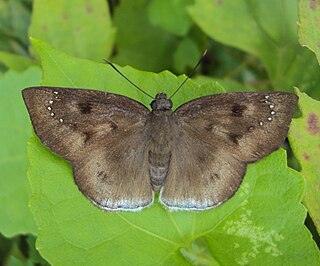
Tagiades gana, the immaculate snow flat, large snow flat or suffused snow flat, is a butterfly belonging to the family Hesperiidae found in Indomalayan realm.

Bibasis harisa, the orange awlet, is a species of hesperid found in Asia. The butterfly was reassigned to genus Burara by Vane-Wright and de Jong (2003) and is considered by them to be Burara harisa.

Bibasis anadi, the plain orange awlet, is a species of hesperid butterfly found in India and Southeast Asia. The butterfly has been reassigned by Vane-Wright and de Jong (2003) to the genus Burara and is considered by them Burara anadi.

Bibasis vasutana, the green awlet, is a species of hesperid butterfly found in Asia. The butterfly was reassigned to genus Burara by Vane-Wright and de Jong (2003) and is considered by them to be Burara vasutana.

Burara amara, the small green awlet, is a species of hesperid butterfly found in Northeast India and Southeast Asia. The butterfly has been reassigned to the genus Burara by Vane-Wright and de Jong (2003) and is now Burara amara.

Bibasis oedipodea, the branded orange awlet, is a species of hesperid butterfly found in South Asia and Southeast Asia. The butterfly was reassigned to the genus Burara by Vane-Wright and de Jong (2003) and is considered by them to be Burara oedipodea.

Hasora anura, the slate awl, is a species of hesperid butterfly found in Asia. In India it is found in Sikkim and the Khasi Hills.
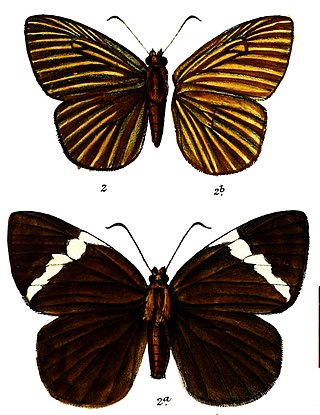
Capila zennara, commonly known as the pale striped dawnfly, is a species of hesperid butterfly found in tropical Asia.



